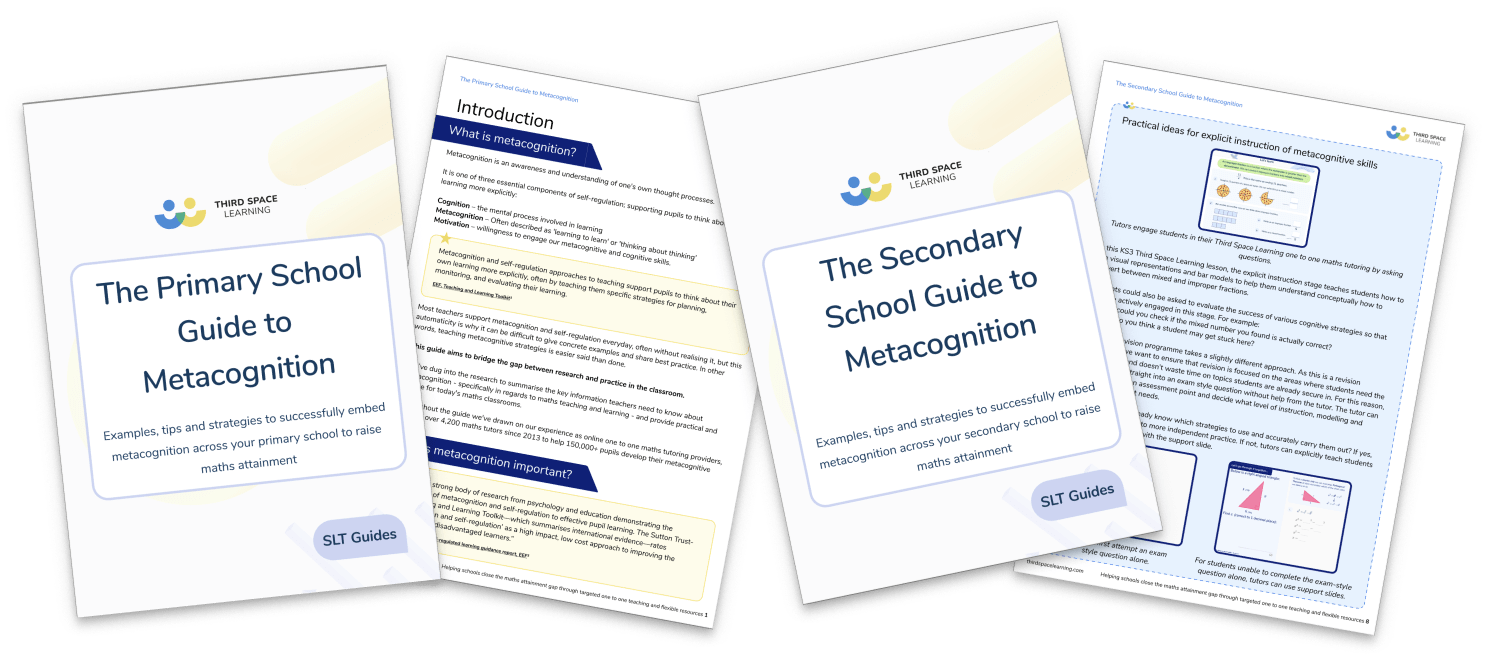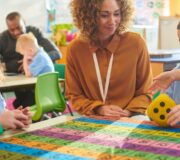Metacognition In The Classroom: A 7-Step Practical Approach To Maths Teaching
The EEF released a report in April regarding the importance of metacognition in the classroom. Here’s what some of these metacognitive strategies look like in practice at the primary maths level, presented as a 7-step teaching model.
- 1. SKILLS: Teachers should acquire the professional understanding and skills to develop their pupils’ metacognitive skills
- 2. MONITOR: Explicitly teach pupils metacognitive strategies, including how to plan, monitor, and evaluate their learning
- 3. MODEL: Model your own thinking to help pupils develop their metacognitive and cognitive processes
- 4. CHALLENGE: Set an appropriate level of challenge to develop pupils’ self-regulation and metacognition
- 5. TALK: Promote and develop metacognitive talk
- 6. ORGANISE: Explicitly teach pupils how to organise and effectively manage their learning independently
- 7. SUPPORT: Schools should support teachers to develop their knowledge of these approaches and expect them to be applied appropriately
- How do we know if our metacognitive strategies in maths are working?
- Never too early to start teaching metacognition
The power of metacognition is something we have hard wired into the Third Space Learning methodology for our AI maths tutoring delivered by Skye, the AI maths tutor. Skye has been trained to use a range of metacognitive strategies to ensure pupils make excellent progress in Maths.
The Ultimate Guide to Metacognition
A guide on everything you need to know to successfully embed metacognition across your primary or secondary school.
Download Free Now!Here we explain exactly what we do to support student learning to help you better understand how to embed a metacognitive approach into your primary school teaching.
What is metacognition in the classroom?
Metacognition in the classroom is the use and explicit teaching of metacognitive strategies to develop independent learners with the skills to understand tasks, select and apply appropriate cognitive strategies, and to evaluate, monitor and reflect on learning.
Why is metacognition in the classroom important?
As the Education Endowment Foundation report says:
‘There is a strong body of research from psychology and education demonstrating the importance of metacognition and self-regulation to effective pupil learning. The Sutton Trust-EEF Teaching and Learning Toolkit—which summarises international evidence—rates ‘metacognition and self-regulation’ as a high impact, low cost approach to improving the attainment of disadvantaged learners. [1]‘
Broadly speaking – it works. Together with cognitive processes and motivation, meta-cognition is key to self-regulated learning, where students actively engage in improving their own learning.
So, here are the 7 steps from the report and guidance to show you how to implement these metacognitive skills in your primary or secondary schools.

Meet Skye, the voice-based AI tutor making maths success possible for every student.
Built by teachers and maths experts, Skye uses the same pedagogy, curriculum and lesson structure as our traditional tutoring.
But, with more flexibility and a lower cost, schools can scale online maths tutoring to support every student who needs it.
Watch Skye in action1. SKILLS: Teachers should acquire the professional understanding and skills to develop their pupils’ metacognitive skills
At Third Space Learning, our AI maths tutor, Skye, has been developed with a focus on pupil success in primary maths, informed by educational research and educational psychology. Our team of former teachers and education experts created a high-quality, structured curriculum and lessons that incorporate best practices. This ensures that pupils receive a consistent and effective learning experience every time.
The lessons are designed to promote active participation and deep understanding. The conversational, voice-based approach encourages pupils to verbalize their reasoning and engage in a dialogue, which helps to build confidence and fluency. Skye’s pedagogical training, which is based on our extensive tutoring experience, allows it to understand ideas and provide reflective feedback, not just mark answers right or wrong. This approach helps pupils feel supported and engaged, which is essential for a positive learning environment.
We have always used the term ‘emotions’ to incorporate the ‘motivation’ aspect the EEF report refers to, as we believe enjoyment and fluent dialogue is also key.
Third Space Learning framework for pupil success, with a focus on metacognition and cognition:

Understand the metacognitive stages for a learner on any task
The first stage for your development is knowing about the processes that a learner goes through.
Here’s what the EEF metacognition report says:
‘We approach any learning task or opportunity with some metacognitive knowledge about:
- our own abilities and attitudes (knowledge of ourselves as a learner);
- what strategies are effective and available (knowledge of strategies); and
- this particular type of activity (knowledge of the task).
When undertaking a learning task, we start with this knowledge, then apply and adapt it. This is metacognitive regulation. It is about planning how to undertake a task, working on it while monitoring the strategy to check progress, then evaluating the overall success.’
This diagram represents the metacognitive regulation cycle as applied to a maths problem:
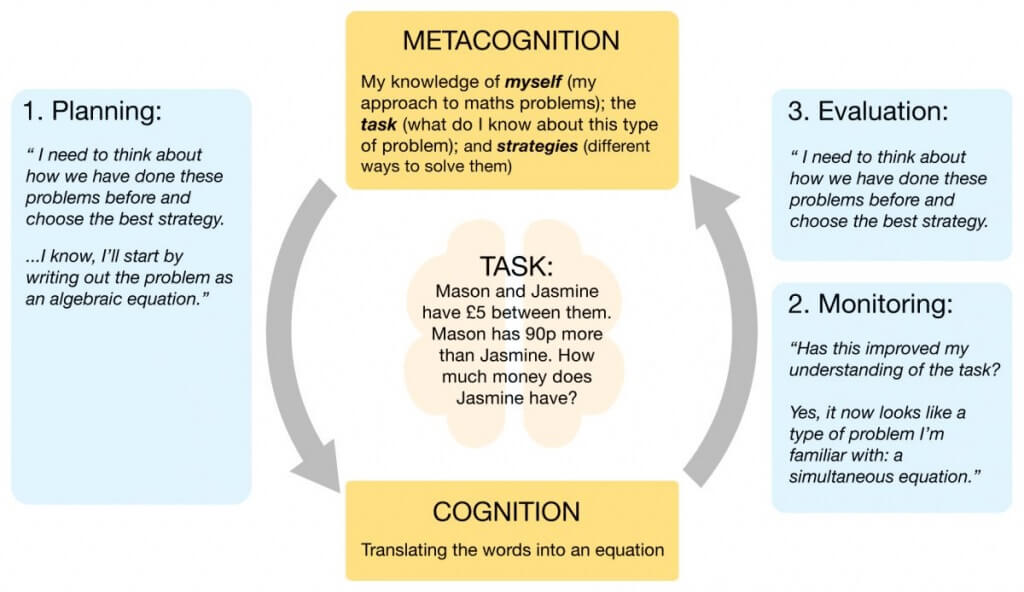
Once you understand that ‘self-regulated learners are aware of their strengths and weaknesses and can […] improve their learning’ you will be closer to supporting them to develop their learning process.
2. MONITOR: Explicitly teach pupils metacognitive strategies, including how to plan, monitor, and evaluate their learning
During the opening of a Third Space Learning lesson, Skye is trained to focus on metacognitive knowledge and previous learning experiences.
Skye asks questions about the pupils’ attitudes and their ability in the topic before they’ve even started on the maths.
From our practice, we’ve found questions like: ‘How do you feel about this topic?’ or ‘How confident are you in solving these types of questions?’ to be a simple but effective starting point.
Questions you can use to start the metacognitive process in the classroom
Skye also investigates what the pupil already knows about the topic and what strategies they are aware of for solving this type of activity, using questioning in the classroom techniques like:
- ‘What strategies do you use when problem solving?’
- ‘What do you notice?’
- ‘What things should you pay careful attention to when solving questions like these?
- ‘Where have you seen these types of questions in real life before?’
In the SATs lessons that form the bedrock of our SATs Revision Programme, Skye explicitly asks pupils to choose from a range of strategies to solve questions, while keeping the goal of the activity in mind. Just like the lesson slide below:
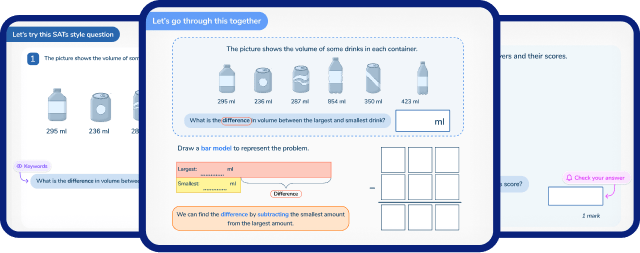

Keep prompting your pupils to be aware of their thought processes in your Maths lessons
Skye does not tell pupils what to do but rather combines explicit input with interactive questioning, pupil choice and feedback.
Skye uses this information to help the pupil with metacognitive regulation (planning, monitoring and evaluating) and decision-making throughout the lesson.
As an example, Skye reminds the pupil about strategies they themselves have highlighted as important in the beginning of the lesson when they get stuck on a question later on.
Questions to use as prompts to elicit metacognition during practice Maths tasks
There are three parts which help a pupil articulate their knowledge of themselves, the task and the strategies. These are:
- ‘What do you notice?’,
- ‘What do you know?’,
- ‘Can you show me your working out?’
Self-reflection is also an important part of the process, e.g.
- ‘Does your answer seem reasonable? Why?’
This maps onto the monitoring and evaluating aspect of regulation strategies.
Metacognitive questions to end a Maths lesson
In closing, each lesson ends with a plenary which once again mimics this continuous cycle of metacognition. See image below.
Here, the pupil completes a self-evaluation of their specific and general progress, skills and strategies which will inform their monitoring and planning for the next time they are working on this topic.
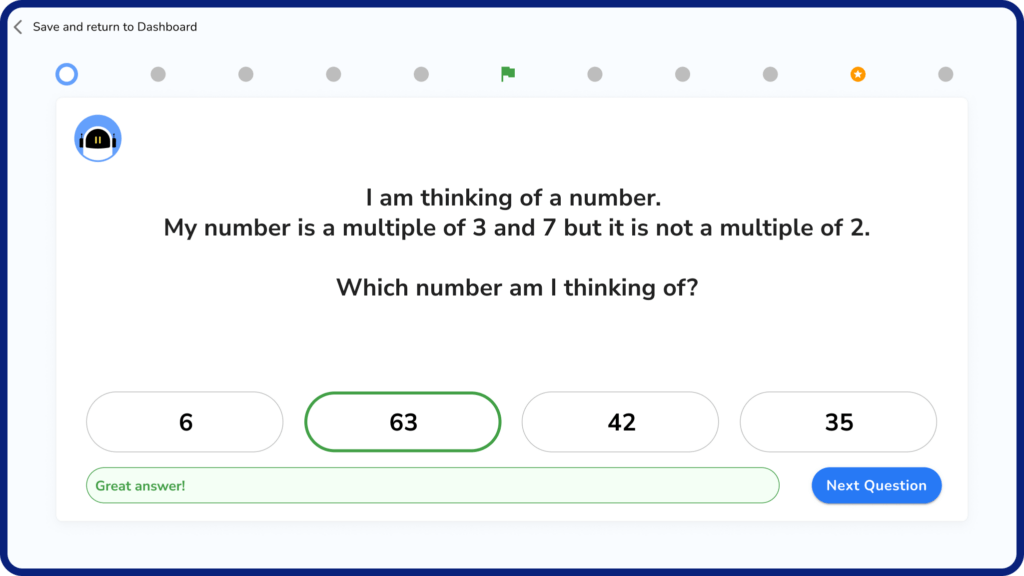
How should teachers teach metacognitive strategies
This is the seven-step model for explicitly teaching metacognitive strategies as recommended by the EEF report:
- Activating prior knowledge;
- Explicit strategy instruction;
- Modelling of learned strategy;
- Memorisation of strategy;
- Guided practice;
- Independent practice;
- Structured reflection.
To see how this works in practice, let’s look at the progression of a Third Space Learning Maths lesson.
We recommend you use this as a model for adapting and adjusting your own plan for a lesson built around metacognition.
1) Activating prior knowledge
The first 4 slides of our Maths lessons deal explicitly with activating prior knowledge. Here, Skye works with the pupil to test recall from the previous week, determine what the pupil understands about the topic already, elicit the topic’s application to the real world, and to help make connections and plan learning goals for the lesson.
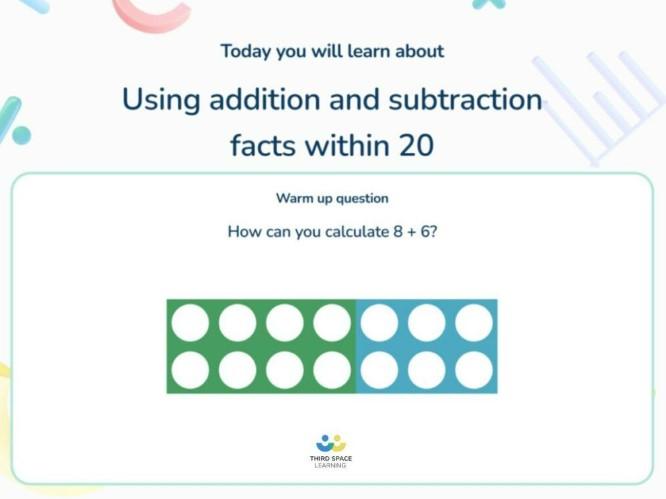
Skye then works through the next four steps using a range of slides (from highly scaffolded to more independent practice).
2) Explicit strategy instruction;
Read more: Direct instruction and Rosenshine Principles
3) Modelling of learned strategy;
4) Memorisation of strategy;
5) Guided practice;
Read more: The 5 Stages Of Deliberate Practice In Education
6) Independent practice
After the instruction period, lessons have ‘Practice time’. This is when pupils can independently complete calculations, with Skye asking higher-level questions and prompting metacognitive thinking and reasoning if required.
At the end of the lesson a child is required to undertake multiple choice questions alone to practise what they have just learnt and embed their learning.
7) Structured reflection
All lessons end with a three part plenary slide as above asking questions around attitude and motivation, metacognition and a chance to evidence progress. This develops students’ metacognition and self-awareness of their learning behaviours. Each of these steps is directly replicable in your primary Maths teaching practice. If you want to get a closer look at the lessons or process we use get in touch with our schools team who’ll be happy to help.
3. MODEL: Model your own thinking to help pupils develop their metacognitive and cognitive processes
The EEF’s guidance report encourages teachers to model their own thoughts and cognitive strategies as they proceed through a lesson. Teachers should then move from a more teacher-led activity to one directed by the student to develop more independent learners.
Third Space Learning’s AI maths tutoring sessions are structured to start with a worked example or highly scaffolded slide where Skye models best practice. This level of scaffolding is gradually reduced to partly completed examples right through to ‘Practice time’ where a pupil should be able to practise more independently.
Look at the transition of these slides, as they move from a more scaffolded approach where more modelling occurs towards a less and less scaffolded approach as the pupil starts working more independently.
Could you do this in your primary classroom?
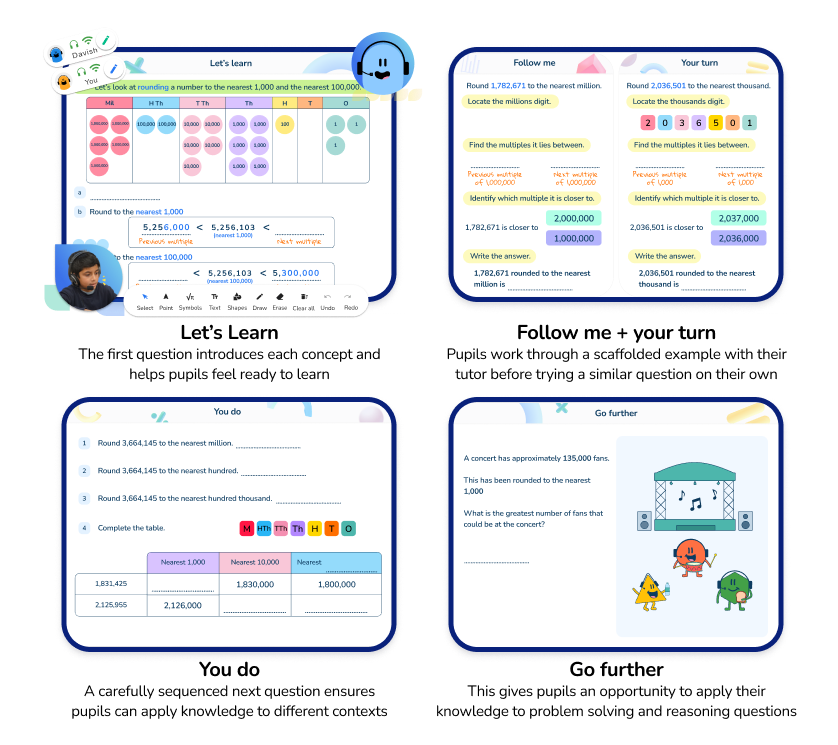
4. CHALLENGE: Set an appropriate level of challenge to develop pupils’ self-regulation and metacognition
The report says:
‘Challenge is key to developing self-regulation and metacognition: if learners are not challenged, they will not develop new and useful strategies; nor will they reflect deeply on the content they are engaging with, or on their learning strategies, or stretch their understanding of themselves. Put simply, and somewhat paradoxically, if pupils have to undertake a task that makes them struggle (remember ‘deliberate difficulties’), they are more likely (in the future) to recall information from such tasks from their long-term memory.’ [21]
Examples of how to keep challenge level up
Skye is trained to make sure the pupil is appropriately stretched and challenged according to his/her ability and/or encouraged to develop critical thinking skills.
In our SATs lessons we have explicitly built opportunities reasoning and challenge into our ‘Go further’ slides.
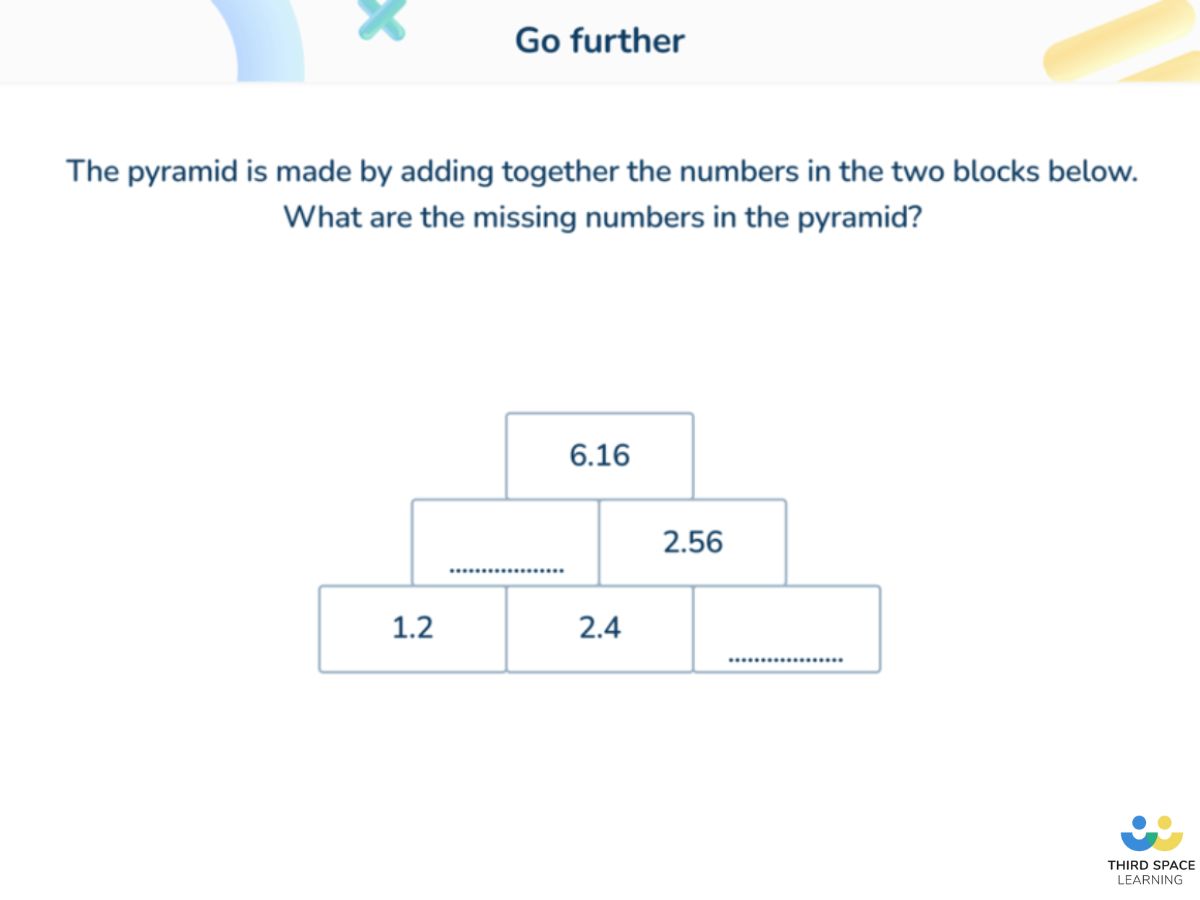
What is an appropriate level of challenge? Looking at John Sweller’s cognitive load theory or Vygotsky’s ‘Zone of proximal development’, we see it is important to make it not too hard, not too easy, but just right.
Delivering tutoring 1-to-1, Skye is able to adapt in real time with the correct amount of scaffolding personalised to each pupil. However, even with a full KS2 primary maths class you will still be expert at building differentiation in the classroom and adapting the task to each child, whether they are high or low ability students.

5. TALK: Promote and develop metacognitive talk
‘Teachers asking challenging questions—guiding pupils with oral feedback, prompting dialogue, and scaffolding productive ‘exploratory’ talk where appropriate—is an ideal way to share and develop effective learning.’[31]
Skye is trained to ask open-ended questions with a focus on reasoning, discussing, arguing, and explaining.
Verbal reasoning is one of the first areas teachers notice improvement in with their pupils on Third Space Learning.
‘It’s a fantastic way to get the children TALKING about their maths and explaining their thinking. Children are keen to participate in the sessions and enjoy them.’
Sara Ellis, Deputy Headteacher, Wyke Regis Junior School
We use Bloom’s Taxonomy to train Skye to ask the right questions. The ultimate aim is to get to the top layer of cognition (see image below) where a pupil is able to create, evaluate and analyse with ideas in a specific topic.
Obviously, it is also important and useful to use aspects of remembering, understanding and applying style questions, in order to build the metacognitive knowledge in this domain to access these higher order skills and reduce pupils’ cognitive load.

Giving pupils a voice is essential to them being able to construct their own meaning and understanding. Tutor talk time should not dominate the lesson as this restricts pupil voice.
At Third Space Learning, we strongly believe this and Skye is trained to minimise talk-time, and maximise pupil talk time.
Are you vigilant about your balance of pupil and teacher talk in your primary classroom?
6. ORGANISE: Explicitly teach pupils how to organise and effectively manage their learning independently
In order to help pupils achieve self-regulated and independent learning, it is important to support pupils to develop study strategies that allow them to plan, monitor and evaluate their own progress.
Specifically, Skye encourages pupils to assess and judge their own thinking processes and understanding during the lesson, in the plenary and formally by completing a pupil feedback form at the end of each lesson.
This allows pupils multiple opportunities to improve accuracy in judgement, especially younger ones, as they tend to struggle with realistic view of how well they learnt something.In addition, the learning programme has been created to help a teacher best support their pupils with the most effective learning techniques such as retrieval practice, practice testing, distributed (‘spaced’) practice and interleaved practice built in as standard.
7. SUPPORT: Schools should support teachers to develop their knowledge of these approaches and expect them to be applied appropriately
As with any changes to classroom practice and pedagogy, teachers need a lot of support, training, and time to practise in order to implement them effectively.
Make sure that metacognition is on your timetable for discussion each year at your in-school CPD sessions. You’ll be surprised how many teachers will already be using these metacognitive strategies without even perhaps realising it. It’s part of good, quality first teaching.
How do we know if our metacognitive strategies in maths are working?
In order to help guide our understanding of self-regulation and metacognition at TSL, we assess our impact by using pupil self reporting questionnaires.
Each programme begins and ends with a ‘Mission Zero’ where we ask cognitive (domain specific), affective (emotional) and meta-cognitive questions. We use machine learning to cluster pupils into groups and then track which areas they have improved in.
This gives Third Space Learning an idea of which areas we are having the most (or least) impact in and this informs and supports how we train Skye, the AI maths tutor, and our curriculum design.
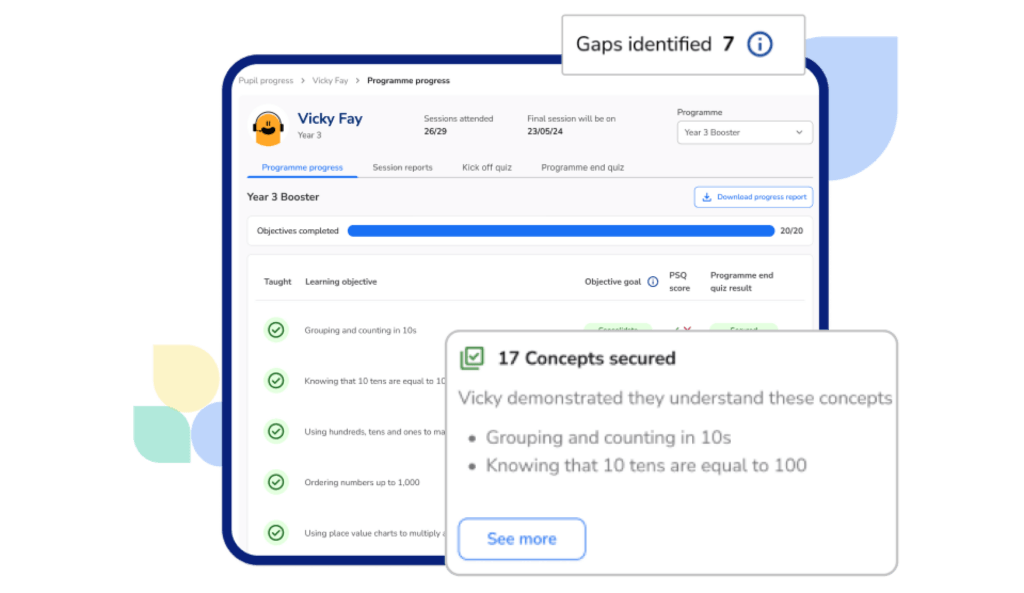

Never too early to start teaching metacognition
We work mostly with KS2 pupils plugging gaps, and fixing common maths misconceptions that have developed over the years at primary school.
But you can start your own work in your school or classroom today, no matter what year group you teach or are responsible for, in much the same way you might have incorporated growth mindset in the classroom.
‘Children as young as three have been able to engage in a wide range of metacognitive and self-regulatory behaviours, such as setting themselves goals and checking their understanding. They also show greater accuracy on tasks they have chosen to accept than on tasks they would have preferred to opt out of.
Although older children typically exhibit a broader repertoire of metacognitive abilities, the evidence suggests that younger children do typically develop metacognitive knowledge, even at a very early age.’
The potential impact of introducing metacognition at the primary school level is great and will support learners from primary school to secondary school, and beyond. Now that you’ve got the evidence and some practical strategies that we know work, what are you going to do about it?
Read more
- Focused Thinking And Goal Free Questions: How I Wish I’d Taught (Primary) Maths
- Learning and Memory in the Classroom: What Teachers Should Know
- How to Support a Child with Autism in the Classroom
- Effective Praise In The Classroom: What Works & What Doesn’t
- Interleaving: What Is It And How Can It Improve Memory And Learning In The Maths Classroom?
DO YOU HAVE STUDENTS WHO NEED MORE SUPPORT IN MATHS?
Skye – our AI maths tutor built by teachers – gives students personalised one-to-one lessons that address learning gaps and build confidence.
Since 2013 we’ve taught over 2 million hours of maths lessons to more than 170,000 students to help them become fluent, able mathematicians.
Explore our AI maths tutoring or find out about maths tuition for your school.



